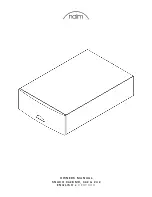
Rear Panel
What is an Active Crossover?
A crossover is a device for separating the high frequencies from the low frequencies in a sound reinforcement system. Passive crossovers exist
in speaker cabinets to split the high and low frequencies of an amplifier output and feed into the appropriate speaker components. This is usually
necessary in cabinets with separate low frequency and high frequency speaker components (woofers and tweeters) but can be inefficient
because it operates on the high energy output from an amplifier and dissipates much energy as heat.
Active crossovers operate
before
the amplifier(s) stage, where the signal is typically less than a Volt, affording accurate and efficient separation
of the component frequencies. Essentially, an active crossover splits each audio signal into 2, 3 or even 4 sets of frequencies, feeding each into
a separate amplifier, which in turn powers a specific speaker component. This allows each speaker component to handle just the type of sound it
produces most efficiently, avoiding wasting energy from the amplifier.
Configuration
The CX23 can be configured as a 2-way stereo or 3-way mono crossover
The CX34 can be configured as a 2-way stereo, 3-way stereo or 4-way mono crossover
The connection and operating mode depends upon the type of amplifier configuration (bi-amp, tri-amp or quad-amp)
Connection
In all configurations, the output(s) (left and right or mono) from the signal source (usually the main mixing console) are connected to the input(s)
of the crossover. All connections are balanced (or unbalanced, if preferred) and should be connected using good quality XLR leads
In a bi-amped system, the LOW (or LF SUM) outputs are connected to the inputs of the power amplifier which will drive the sub cabinets and the
HIGH outputs are connected to the inputs of the power amplifier which will drive the mid-top cabinets.
In a tri-amped system, the LOW (or LF SUM) outputs are connected to the inputs of the power amplifier which will drive the sub cabinets, the
MID outputs are connected to the power amplifier which will power the main drivers of the mid-top cabinets and the HIGH outputs are connected
to the inputs of the power amplifier which will drive the high frequency drivers in the mid-top cabinets
In a quad-amped system, the LOW (or LF SUM) output is connected to the input of the power amplifier which will drive the sub cabinets, the
LOW-MID output is connected to the power amplifier which will power the dedicated mid-range cabinets, the HIGH-MID outputs are connected to
27.
Voltage selector
28.
IEC mains inlet
29.
High output: Channel B
30.
High-mid or Mid output: Channel B
31.
Low or Mid output: Channel B
32.
Low output: Channel B
33.
Crossover frequency multiplier: Channel B
34.
Input: Channel B
35.
Mode selector buttons
36.
Mono Normal/Summed switch
37.
High output: Channel A
38.
Low-mid or Mid output: Channel A
39.
Low output: Channel A (or LF Sum both channels)
40.
Crossover frequency multiplier: Channel A
41.
Input: Channel A









